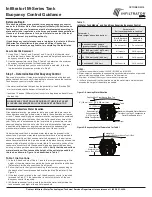
Before you Begin
This document presents a method for assessing buoyancy control
needs for Infiltrator Water Technologies (Infiltrator) IM-Series tanks.
Tank buoyancy control measures must be implemented according to
state and/or local regulations, which may supersede these guidelines.
If unsure of the requirements for a particular site, contact the local
health department or permitting authority.
If tank buoyancy control measures are implemented, refer to Infiltrator
IM-Series Tank Installation Instructions and Riser Connection
Guidance documents, as applicable, for completing the installation.
How to Use this Document
1. Using Step 1, Table 1 and Figures 1 and 2, verify that the water level
outside the tank is below the outlet pipe saddle height and determine if
buoyancy control is required.
2. Use the appropriate row in Step 2, Table 2 to determine the minimum
buoyancy control methods for the site conditions.
3. Once the preferred buoyancy control method is selected, follow the
implementation procedures provided in Step 3.
Step 1 – Determine Need for Buoyancy Control
Required information: (1) maximum height of water outside the tank and
above the tank bottom; and (2) the depth of soil cover above the tank top.
Tank buoyancy control may be required if:
• the water level outside the tank has the potential to rise 30 inches (750
mm) or more above the bottom of the tank; and
• less than 12 inches (300 mm) of soil cover is to be placed as backfill over
the tank top.
Allowable Subsurface Water Elevation
Groundwater elevation, groundwater table, and water table are terms for
the subsurface condition where water is held in the subsurface soil pores
or rock. The seasonal high groundwater elevation represents the sustained
highest point the water table has the potential to reach at any time of the
year. That point is not necessarily the level at which groundwater may be
observed seeping from the soil at the time of tank installation. In general,
a qualified soil evaluator or engineer can estimate the seasonal high
groundwater elevation from careful examination of the soil profile.
Under certain conditions, a perched water table may be present in the
subsurface. A perched water table occurs where there is an impermeable
or low-permeability soil that causes water to be present in the soil pores
above the main water table. A perched water table elevation may exceed the
seasonal high elevation of the main water table. The vertical position of the
tank must account for both the seasonal high groundwater table and any
existing or future perched water table condition. Verify that the subsurface
water elevation will not exceed the height of the outlet pipe saddle of
the tank, as shown in Figure 1 and described in Table 1.
Table 1 Instructions
1. In the left-hand column of Table 1, locate the row corresponding to the
height of the water elevation outside the tank and above the tank bottom
(Parameter I) for the site conditions. See Figure 2.
2. Follow that row to the right until reaching the column corresponding to
the depth of soil cover proposed above the tank top (Parameter II). See
Figure 2.
3. If the tank model is listed in that cell, then buoyancy control is required
(proceed to Step 2). If the tank model is not listed in that cell, then no
buoyancy control is required.
4. IM-Series tanks shall not be installed where the water level outside the
tank exceeds the height of the outlet pipe saddle.
Infiltrator IM-Series Tank
Buoyancy Control Guidance
OCTOBER 2016
Table 1:
Infiltrator Tank Models
1
and Conditions Requiring Buoyancy Control
Parameter I:
Water height
2
above tank bottom
Parameter II:
Soil cover depth above tank top
3
A
B
6 in (150 mm) to
12 in (300 mm)
Above 12 in
(300 mm)
1
Above outlet pipe saddle
4
(greater than 43” [1,075 mm])
Do not install
Do not install
2
36” (900 mm) to 43” (1,075 mm)
(to outlet pipe saddle)
All models
Not Required
3
30” (750 mm) to 36” (900 mm)
IM-1530
Not Required
4
Less than 30” (750 mm)
Not Required
Not Required
NOTES:
1. Infiltrator tank models include: IM-540, IM-1060, and IM-1530.
2. Water height corresponds to seasonal high groundwater elevation or perched
water elevation measured from bottom-of-tank elevation.
3. Minimum 6 inches (150 mm) soil cover backfill is required.
4. IM-Series tanks shall not be installed where the water level outside the tank
exceeds the height of the outlet pipe saddle.
Figure 2: Buoyancy Control Parameters for Table 1
Figure 1: Assessing Water Elevation
Parameter I
Water Height
Above Tank Bottom
Parameter II
Depth Of Soil Cover Above Top Of Tank
NO BUOYANCY CONTROL IS REQUIRED IF THERE IS AT LEAST
12 INCHES (300 MM) OF SOIL COVER ABOVE THE TANK TOP.
Maximum Allowable Water Elevation
Outside of the Tank Corresponds to
Outlet Pipe Saddle Invert
Tank Bottom
6” (150 mm) min – 48” (1,200 mm) max.
13” (330 mm)
Seasonal High
Groundwater 43”
(1,075 mm) max.
Above Tank Bottom
Depth of Soil Cover Above Tank Top
Top Of Tank
Contact Infiltrator Water Technologies’ Technical Services Department for assistance at 1-800-221-4436.






















